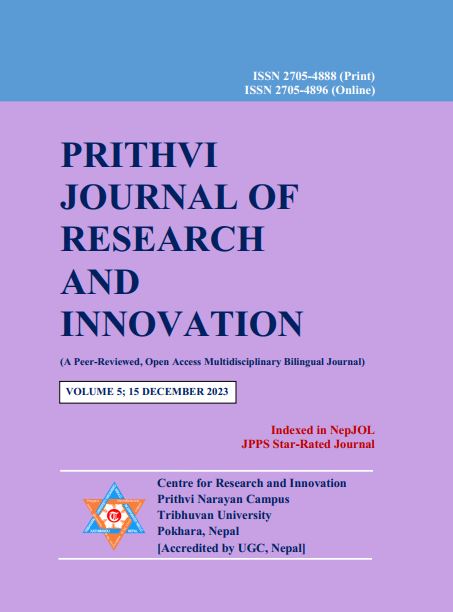अग्नि महाकाव्यमा दलित उत्पीडन र प्रतिरोधको विमर्श [Dalit Subjugation and Resistance in the Epic Agni]
DOI:
https://doi.org/10.3126/pjri.v5i1.60702Keywords:
दलित साहित्य, उत्पीडन, प्रतिरोध, वर्णव्यवस्था, [Dalit literature, subjugation, resistance, caste systemAbstract
नवराज लम्सालको अग्नि (२०७८) महाकाव्य दलित समस्याको केन्द्रीयतामा रचिएको हुँदा यहाँ सोही कोणबाट विमर्श गरिएको छ । दलित साहित्य सिद्धान्तका आधारमा विमर्श गरिएको हुँदा यसको विमर्श पद्धति मूलतः निगमनात्मक विधिमा आधारित छ । यसको विषय विश्लेषण गुणात्मक शोधको ढाँचामा छ । यसका आधार र सैद्धान्तिक सामग्री पुस्तकालयबाट लिइएका हुँदा सामग्रीको स्रोत भने पुस्तकालय हो । गैरदलितले दलित समस्याकेन्द्री रचना लेख्नु आफैमा निकै चुनौतीपूर्ण विषय भए पनि नेपाली महाकाव्य परम्परामा यस महाकाव्यको रचना निकै सार्थक बनेको छ किनभने यसमा दलितको लुप्तप्रायः इतिहासलाई नवइतिहासवादी कोणबाट उत्खनन गरी बुनिएको छ । जातीय विभेदमा आधारित उत्पीडनका कारण दलित साहित्यमा धेरैजसो देखिने दलितका आवेग, आक्रोश र विद्रोहका चर्का रूप यसमा नदेखिए पनि गैरदलित महाकाव्यकारको सुधारवादी दृष्टिकोणकै परिधिमै यसमा संयमित आवेग, आक्रोश र प्रतिरोध चेतना आएका छन् । तिनको अभिव्यक्ति ठुले कामी, छेलाङी विश्वकर्मा र जुनीमायामार्फत गरिएको छ । ऐतिहासिक पात्र ठुले कामीमा प्रतिरोध चेतना रहे पनि उनले उत्पीडक सामु व्यक्त गर्न सकेका छैनन् तर मर्ने बोलामा छोरा सामु तीप्रतिको घृणा भाव व्यक्त गर्दै सन्तानलाई सचेत त बनाएका छन् । वर्तमान समयका छेलाङी र जुनीमायाले भने तार्किक ढङ्गमै प्रतिरोध गरेका छन् । छेलाङीको प्रतिरोधमा बौद्धिकता र तार्किकता बढी पाइन्छ भने जुनीमायाको प्रतिरोधमा व्यावहारिकता बढी देखिएको छ । आप्mनो उत्पीडनप्रति गरिएको दलितको यही संयमित प्रतिरोध चेतनाले महाकाव्य सामयिक र आकर्षक बनेको छ ।
[Naba Raj Lamsal’s epic Agni (2078 BS) has been interpreted from the Dalit perpective. The study adopts the deductive research method to discuss the epic, which is based on the theories of Dalit literature, using the qualitative research design. The study depends on the secondary sources retrieved from the library, using both print and e-resources. Although there are challenges to study on the Dalit issues as the theme of the epic which is created by an author who belongs to a caste other than the Dalit, the epic has reclaimed the subjugated history of Dalits that is portrayed from the neo-historist point of view. The epic has brought out the suppression of minority people like the Dalits, dealing with inner awareness such as emotions, resentments and protests. Such awareness of resistance is expressed through the characters like Thule Kami, Chhelangi Bishwokarma, and Junimaya. Despite the fact that the characters have the awareness of resistance, but in the case of Thule Kami who is a subaltern character cannot express his suppression though he tells his son to be aware of casteism at his death bed. However, Chhelangi and Junimaya have resisted the urge to alter the casteism related discriminations. Whereas Chhelangi’s resistance is driven by intellect and logic, Junimaya’s resistance is driven by practicality. Thus, the balanced portrayal of characters has popularized the epic and has become a historical document for the Dalit writing in Nepal.]
Downloads
Downloads
Published
How to Cite
Issue
Section
License

This work is licensed under a Creative Commons Attribution-NonCommercial 4.0 International License.
© Centre for Research and Innovation (CRI), Prithvi Narayan Campus (TU)

